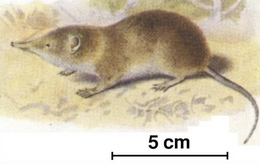Myosorex
| Myosorex | ||||||||||||||||||||||||||
|---|---|---|---|---|---|---|---|---|---|---|---|---|---|---|---|---|---|---|---|---|---|---|---|---|---|---|
 Rajz az erdei őscickányról (Myosorex varius)
| ||||||||||||||||||||||||||
| Rendszertani besorolás | ||||||||||||||||||||||||||
| ||||||||||||||||||||||||||
| Hivatkozások | ||||||||||||||||||||||||||
A Wikimédia Commons tartalmaz Myosorex témájú kategóriát. |
A Myosorex az emlősök (Mammalia) osztályának Eulipotyphla rendjébe, ezen belül a cickányfélék (Soricidae) családjába és az afrikai fehérfogú cickányok (Myosoricinae) alcsaládjába tartozó nem.[1]
Alcsaládjának a típusneme.
Előfordulásuk
[szerkesztés]A Myosorex-fajok kizárólag a Szahara alatti Afrikában fordulnak elő.
Rendszerezés
[szerkesztés]A nembe az alábbi 19 élő faj tartozik:[2][3][4][5]
- Myosorex babaulti Heim de Balsac & Lamotte, 1956
- Myosorex blarina Thomas, 1906
- Myosorex bururiensis Peterhans & Hutterer, 2011
- Myosorex cafer (Sundevall, 1846)
- biokói őscickány (Myosorex eisentrauti) Heim de Balsac, 1968
- Myosorex geata (G. M. Allen & Loveridge, 1927)
- Myosorex gnoskei Peterhans et al., 2008
- Myosorex jejei Kerbis Peterhans, J.C. et al. 2010
- Myosorex kabogoensis Peterhans & Hutterer, 2013
- Myosorex kihaulei Stanley & Hutterer, 2000
- Myosorex longicaudatus Meester & Dippenaar, 1978
- Myosorex meesteri Taylor et al., 2013
- bemanda-fennsíki őscickány (Myosorex okuensis) Heim de Balsac, 1968
- rumpi-hegységi őscickány (Myosorex rumpii) Heim de Balsac, 1968
- itombwe-hegységi őscickány (Myosorex schalleri) Heim de Balsac, 1966
- Myosorex sclateri Thomas & Schwann, 1905
- Myosorex tenuis Thomas & Schwann, 1905
- erdei őscickány (Myosorex varius) (Smuts, 1832) - típusfaj
- Myosorex zinki Heim de Balsac & Lamotte, 1956
Jegyzetek
[szerkesztés]- ↑ Gray (1838). Proceedings of the Zoological Society of London 5: page 124.
- ↑ (2011) „African Shrews Endemic to the Albertine Rift: Two New Species of Myosorex (Mammalia: Soricidae) from Burundi and the Democratic Republic of Congo”. Journal of East African Natural History 99 (2), 103–128. o. DOI:10.2982/028.099.0201.
- ↑ (2008) „First record of Myosorex (Mammalia: Soricidae) from Malawi with description as a new species, Myosorex gnoskei”. Journal of East African Natural History 97 (1), 19–32. o. DOI:[19:fromms2.0.co;2 10.2982/0012-8317(2008)97[19:fromms]2.0.co;2].
- ↑ (2013) „Mammals, other than bats, from the Misotshi-Kabogo highlands (eastern Democratic Republic of Congo), with the description of two new species (Mammalia: Soricidae)”. Bonn Zoological Bulletin 62 (2), 203–219. o.
- ↑ (2013) „Cryptic diversity in forest shrews of the genus Myosorex from southern Africa, with the description of a new species and comments on Myosorex tenuis”. Zoological Journal of the Linnean Society 169 (4), 881–902. o. DOI:10.1111/zoj.12083.
Források
[szerkesztés]- Dr. Berend Mihály, Dr. Szerényi Gábor: BIOLÓGIA II., Állattan, Ökológia, 275 old.
- Örösi Pál Zoltán: Méhek között (1957).
- ITIS rendszerbesorolása
- Novum állatvilág enciklopédia III.: Emlősök III.: Kisebb növényevők, rovarevők és erszényesek. Szerk. David MacDonald. Szeged: Novum. 2009. ISBN 978-963-9703-57-5 – magyar nevek egy része
- Heim de Balsac H., & Lamotte, M. 1956. Evolution et phylogénie des Soricidés africains-I. Mammalia 20:140–167.
- Quérouil S., R. Hutterer, P. Barrière, M. Colyn, J.C. Kerbis Peterhans, & E. Verheyen. 2001. Phylogeny and Evolution of African Shrews (Mammalia: Soricidae) Inferred from 16s rRNA Sequences. Molecular Phylogenetics and Evolution 20(2):185–195
- Mammal Species of the World. Don E. Wilson & DeeAnn M. Reeder (szerkesztők). 2005. Mammal Species of the World. A Taxonomic and Geographic Reference (3. kiadás) (angolul)
- Kerbis Peterhans, J.C. et al. 2010. African shrews endemic to the Albertine Rift: two new species of Myosorex (Mammalia: Soricidae) from Burundi and the Democratic Republic of Congo. Journal of East African natural history 99(2): 103–128. doi: 10.2982/028.099.0201
- Taylor, P.J. et al. 2013. Cryptic diversity in forest shrews of the genus Myosorex from southern Africa, with the description of a new species and comments on Myosorex tenuis. Zoological journal of the Linnean Society 169(4): 881–902. doi: 10.1111/zoj.12083 Reference page.

